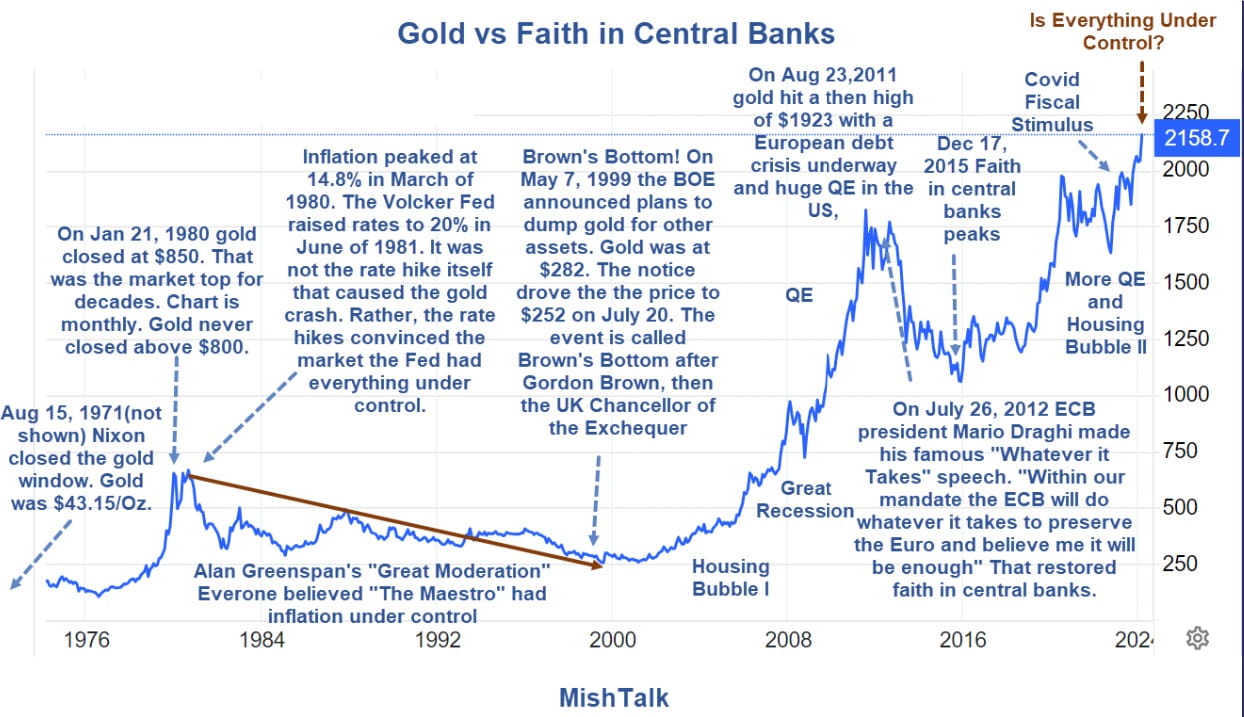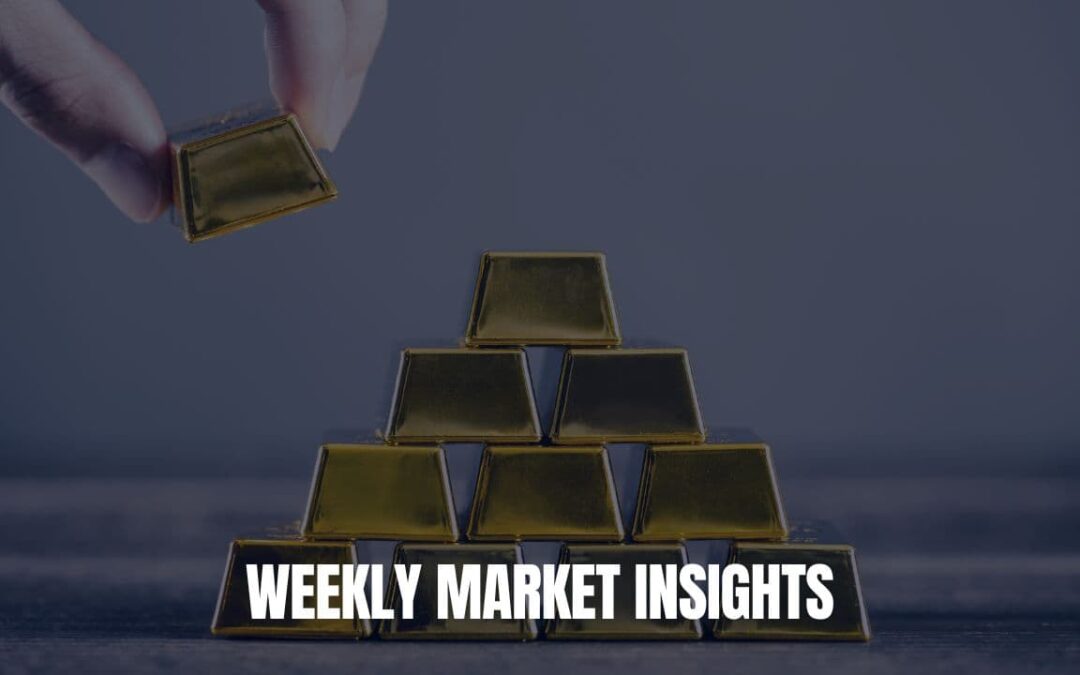As we delve into another week of market dynamics, it’s evident that volatility remains a persistent force shaping investor sentiment and decision-making. From the intricacies of US employment data to the ripple effects of geopolitical tensions, the landscape of global markets is constantly evolving, presenting both challenges and opportunities for investors. Our chart of the week, covers the surge in the price of gold, marking a nearly 5% gain in the prior week and reaching record territory, it has captured the attention of investors worldwide.

US Economic Landscape
Last week, the United States witnessed yet another impressive display in its employment data, with Nonfarm Payrolls surpassing expectations by over 300,000. However, beneath the surface, the picture isn’t entirely rosy, as the surge in part-time jobs contrasts with stagnation in full-time employment. This nuanced scenario underscores the importance of digging deeper into economic indicators to glean actionable insights.
Amidst this backdrop, the US dollar’s performance is notable. Despite robust economic data, the dollar failed to gain traction, exemplifying the complex interplay of factors influencing currency markets. The Dollar Index (DXY) experienced a marginal decline, while currencies like the Euro and Pound maintained sideways movement amid anticipation of potential rate cuts by their respective central banks in 2024.
Commodities and Precious Metals
Commodity markets witnessed varied movements, with commodity currencies displaying resilience amidst a stall in the dollar’s momentum. Notably, oil prices rallied for the second consecutive week, fuelled by concerns stemming from global geopolitical risks. Such fluctuations underscore the interconnectedness of geopolitical events and commodity price movements, highlighting the need for a comprehensive understanding of market dynamics.
In the realm of precious metals, a remarkable surge was observed despite rising yields, signalling a growing realisation among market participants regarding the sustainability of the US and global debt levels. Gold soared almost 5% to close at $2,330, while Silver recorded a staggering 10% increase. These movements underscore the role of precious metals as a hedge against economic uncertainty and inflationary pressures.
Equity Markets and Fixed Income
Equity markets continue to defy conventional expectations, with indices like the S&P 500 maintaining a broad uptrend despite headwinds such as robust jobs reports and rising yields. The S&P 500 index, for instance, experienced a marginal decline of 0.8%, highlighting the resilience of equities in the face of evolving market dynamics. However, it’s crucial for investors to remain vigilant amidst ongoing volatility, adopting a diversified approach to mitigate risks and capitalize on opportunities.
On the fixed income front, bonds experienced a sell-off as expectations for further rate cuts in 2024 diminished. The 10-year US Treasury (UST) yield rose significantly, closing at 4.40%, while the 10-year Bund also faced downward pressure, closing 0.8% lower. These developments underscore the importance of closely monitoring central bank policies and economic indicators to navigate fixed income markets effectively.
Looking Ahead: Key Considerations
As we embark on the upcoming week, heightened volatility is expected to persist, fuelled by major economic data releases and central bank decisions. Key events to watch include inflation data from the US, Mexico, Japan, Norway, and Germany, with particular emphasis on the US Consumer Price Index (CPI). Additionally, interest rate decisions from the Bank of Canada and the European Central Bank (ECB) are poised to shape market sentiment and direction.
Navigating Volatility: Tips for Investors
1. Stay Informed: Keep abreast of economic indicators, central bank announcements, and geopolitical developments to make informed investment decisions.
2. Diversification is Key: Maintain a diversified portfolio across asset classes to mitigate risks and capitalize on opportunities in volatile markets.
3. Long-Term Perspective: Focus on long-term investment objectives and resist the temptation to react impulsively to short-term market fluctuations.
4. Risk Management: Implement risk management strategies and asset allocation adjustments, to protect capital in turbulent market conditions.
5. Seek Professional Guidance: Consider consulting with our financial advisers to develop a personalised investment strategy tailored to your financial goals and risk tolerance.
In conclusion, while volatility may present challenges, it also offers opportunities for astute investors to capitalise on market inefficiencies and navigate uncertainty with confidence. By staying informed, maintaining a diversified portfolio, and adopting prudent risk management practices, investors can position themselves for long-term success amidst the ebb and flow of global financial markets.
Note: Market conditions are subject to change, and this overview is based on information available at the time of writing.
Sources: Reuters, Bloomberg, CNBC and Financial Times
FAQs
1. What are the main drivers of market volatility?
Market volatility can stem from a variety of factors, including economic indicators, geopolitical events, corporate earnings reports, and changes in investor sentiment. Understanding these drivers is essential for navigating turbulent market conditions effectively.
2. How can investors protect their portfolios during periods of volatility?
Investors can safeguard their portfolios by diversifying across different asset classes, implementing risk management strategies, maintaining a long-term perspective, and staying informed about market developments. Additionally, seeking guidance from our financial advisers can help tailor a portfolio strategy to individual risk tolerance and investment goals.
3. What impact do central bank policies have on market volatility?
Central banks play a crucial role in shaping market volatility through their monetary policy decisions, including interest rate changes, quantitative easing programs, and forward guidance. Market participants closely monitor central bank announcements and economic data releases for insights into future policy actions, which can influence investor expectations and market sentiment.
4. How do geopolitical tensions affect financial markets?
Geopolitical tensions, such as conflicts, trade disputes, or geopolitical unrest, can significantly impact financial markets by creating uncertainty and volatility. Investors often respond to geopolitical developments by adjusting their portfolios, leading to fluctuations in asset prices across various markets.
5. What are the implications of rising commodity prices for investors?
Rising commodity prices, such as oil or precious metals, can have both positive and negative implications for investors. While commodity-producing companies may benefit from higher prices, consumers and industries that rely on commodities as inputs may face increased costs. Understanding the broader economic implications of rising commodity prices is essential for making informed investment decisions.
6. How does inflation impact investment strategies?
Inflation can erode the purchasing power of investments over time, making it essential for investors to consider inflation protection strategies. Assets such as inflation-linked bonds, real estate, and commodities may offer protection against inflationary pressures. Additionally, investing in companies with pricing power or dividend-paying stocks can help mitigate the effects of inflation on investment returns.
7. What role do economic indicators play in shaping market sentiment?
Economic indicators, such as GDP growth, unemployment rates, and consumer confidence surveys, provide valuable insights into the health of the economy and can influence market sentiment. Positive economic data releases may boost investor confidence and drive market rallies, while negative data may lead to increased uncertainty and volatility.
8. How should investors interpret stock market performance during volatile periods?
During volatile periods, stock market performance may fluctuate significantly, leading to both gains and losses for investors. It’s essential for investors to maintain a long-term perspective and focus on fundamental factors driving company performance rather than short-term market fluctuations. Additionally, employing disciplined investment strategies, such as dollar-cost averaging or value investing, can help mitigate the impact of volatility on investment returns over time.
If you have specific questions or concerns about your investments, don’t hesitate to reach out to our financial advisers for personalised guidance and recommendations.
Schedule Your Personalised Consultation Today!
Ready to take the next step towards achieving your financial goals? Schedule a call with one of our expert advisers today! Our team are here to provide guidance based on your unique financial situation and help you make the most of the insights gained from our resources. Don’t miss out on the opportunity to receive professional advice and tailored strategies. Take action now and let us guide you towards a brighter financial future.
Discover Market Insights!
Are you eager to make informed and strategic investment decisions? Look no further! Visit our Market Analysis page now to gain exclusive access to expert insights, trends, and data that can help shape your investment journey.
Access Our Financial Calculators!
Take control of your financial future with our comprehensive suite of Financial Calculators. Whether you’re planning for retirement, considering a mortgage, or exploring investment opportunities, our powerful tools can provide valuable insights to guide your decisions.
Disclaimer: The information provided on this website is for general informational purposes only and does not constitute financial or investment advice. The content on this website should not be considered as a recommendation or offer to buy or sell any securities or financial instruments. Investing in securities involves risks, and past performance is not indicative of future results. The value of an investment may fall as well as rise. You may get back less than the amount invested. Any reliance you place on such information is strictly at your own risk. The commentary provided should not be taken as financial advice as it does not take your financial circumstances into consideration and does not provide an objective view with your requirements in mind. The views are our opinions at the time of writing and may change based on incoming information. The data shared may be incorrect or out-dated at the time of reading. Our opinions are subject to change without notice and we are not under any obligation to update or keep this information current. The views expressed may no longer be current and may have already been acted upon. Tax treatment depends on individual circumstances and all tax rules may change in the future. The information contained on this page has been prepared using all reasonable care. However, it is not guaranteed as to its accuracy, and it is published solely for information purposes.
